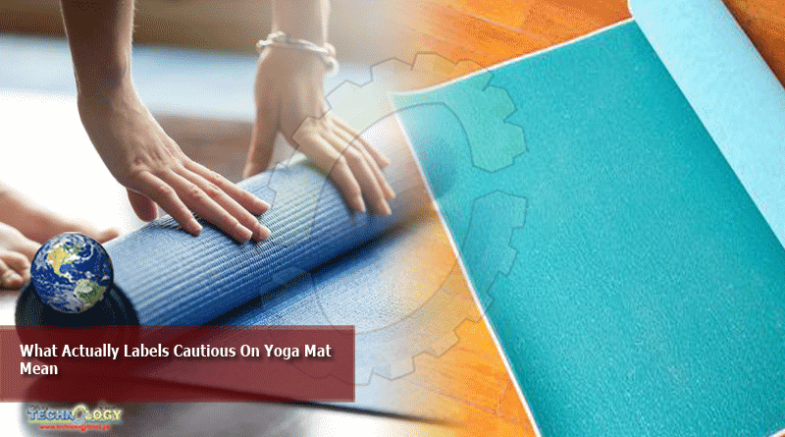I Needed A Yoga Mat And The Price Seemed Right, Just $7.99 At Marshalls, So I Happily Brought It Home

But just as I was about to unwrap it, I saw a label that suddenly made me feel very differently about my purchase. “WARNING: Cancer and Reproductive Harm,” it said in small text. Then it gave a web address: P65warnings.ca.gov.
I freaked out and posted a photo of the mat along with a “does anybody know what this means??” caption on Instagram. After getting no science-backed answers from my network, I decided to figure it out for myself. My first step was to go to the suggested website written on the mat.
I learned that the scary label is required by a 34-year-old California law called Proposition 65. It requires businesses to provide warnings about significant exposures to chemicals that cause cancer, birth defects or other reproductive harm. Since manufacturers don’t want to have to make different labels for different states, those California warnings end up on products sold all over, including New York City, where I live now.
The problem with the label is: While it tells you that something in the yoga mat might give you cancer or affect your ability to have kids, it doesn’t tell you what that substance is, how you might get exposed to it, or — most importantly — what the level of risk is. Turns out I wasn’t the only one concerned. Other people who bought similar yoga mats were just as worried — both by the label, and by reports of a strong odor. One Amazon reviewer wrote that she was “shocked” by the label, and that when she unwrapped it she was “knocked over by the odor.”
What I wanted to know is, how worried should I be about this? Well, it’s not exactly easy to answer.
The most common chemical found in my yoga mat — and some other mats, too — is polyvinyl chloride (PVC), a plastic used in thousands of products: everything from pipes and wall coverings to children’s toys and, yes, some yoga mats.
Some environmental health researchers worry about PVC because its most important feed stock, vinyl chloride gas, is classified as a known human carcinogen by the U.S. Environmental Protection Agency based on animal tests. For example, a 2018 inhalation study found that when mice were exposed even to low levels of vinyl chloride gas — levels below the current Occupational Safety and Health Administration limit of 1 part per million — they suffered liver damage.
But there are two problems: mice are not humans, and vinyl chloride gas is definitely not the same as solid PVC. “At this time, it’s unclear if our results from mice can be translated to health effects in humans,” says Juliane Beier, co-author of the 2018 study and a biochemist at the University of Pittsburgh. The effects of low-level exposures on humans, she adds, are still largely unknown. Even more importantly, Beier notes, the health effects of vinyl chloride and PVC cannot be compared. “The toxicity of vinyl chloride is almost exclusively associated with its gaseous properties,” says Beier.
There’s a further complication as well. The Lotus mat isn’t made only of PVC, which would be far too rigid to be comfortable. To soften the mat and make it more pliable, the PVC is mixed with softening agents known as phthalates.
The problem with phthalates is that when heated they tend to leach out of whatever material they’re embedded in. When that happens, phthalate molecules can attach to dust particles and be inhaled. A 2018 study in the journal Environmental Research measured the emission concentrations of phthalates in five PVC-containing consumer products — one of them yoga mats — at different temperatures. It concluded that at a temperature of 104 degrees Fahrenheit — a typical temperature of a hot yoga room — the total phthalate concentrations in the air increased only moderately from about .2 parts per billion to about 1 part per billion.
So what does this mean for your health? “We cannot tell that simply”, acknowledges Ki-Hyun Kim, a co-author of the phthalates study. Poor quality control by the manufacturer can lead to higher exposures in some mats, but the study didn’t test for that, says Kim.
For a more typical lower-level exposure to phthalates, there is no consensus on the risks, according to the Centers for Disease Control and Prevention. While some types of phthalates have affected the reproductive systems of laboratory animals, research on human health effects is still sparse and equivocal, according to a well-cited paper that reviewed dozens of studies published between 1973 and 2005.
So are PVC and phthalates the only concerns in my yoga mat? Not quite. When PVC burns it can release a much more hazardous group of chemicals called dioxins, which are “one of the most toxic manmade chemicals known to science,” according to Mike Schade, a Mind the Store campaign director at Safer Chemicals, Healthy Families, a DC-based non-profit that seeks to reduce toxic risks. In 2005, he and his team successfully lobbied for the city’s Local Law 120 which requires New York City to reduce the purchase of products whose combustion leads to the formation of dioxin.
To reduce the risk of fire, my yoga mat also contains organophosphate flame retardants, or PFRs. But PFRs carry their own risks: a study published in 2017 in the journal Environmental Health Perspectives, for example, concluded that exposure to PFRs affects fertility. The researchers followed 211 women who went to Massachusetts General Hospital to be evaluated for in vitro fertilization. The researchers checked the women’s urine for metabolized PFRs and found that those who had the highest amount of two specific metabolites, DPHP and ip-PPP, in their urine were 10% less likely to achieve fertilization, 31% less likely to have an embryo successfully implanted in their uteruses, and 41% less likely to achieve pregnancy, compared to those who had significantly lower levels of those metabolites in their urine.
So does that mean that using my yoga mat would affect my chances of having a successful pregnancy? There’s no way to know, because the Massachusetts study did not attempt to determine PFR exposure levels for people who used various products that contained the retardant, according to an article by Dr. Bruce Lee, an internal medicine physician and professor at the City University of New York who was not involved with the study.
What does seem clear is that PFR molecules are so common in the air that eliminating one source of them — such as my yoga mat — might not affect my overall exposure very much, according to another study.
So, what’s the takeaway from this exploration of the potential hazards of my yoga mat? My conclusion is that while the risks seem to be pretty low, the experts know enough to be concerned — and that there is still a huge amount of uncertainty due to gaps in the data and the fact that because controlled experiments on rodents in laboratories aren’t comparable to human risks in the real world.
That uncertainty is why many environmental groups advocate for a precautionary approach that promotes safer alternative products, just in case. “Listen: chances are, it’s not going to make you sick in the near term,” says Schade. “We’re not saying throw away your yoga mat. But it’s contributing to exposure to chemicals that over time could maybe pose a risk to your health.”
In the end, I decided to take the yoga mat back to Marshalls and return it. I ended up purchasing a yoga mat made entirely out of cork online. It’s four times the price of my PVC yoga mat, but without the scary warning label, meditating won’t, counterproductively, stress me out.
This news was originally published at scienceline.org
